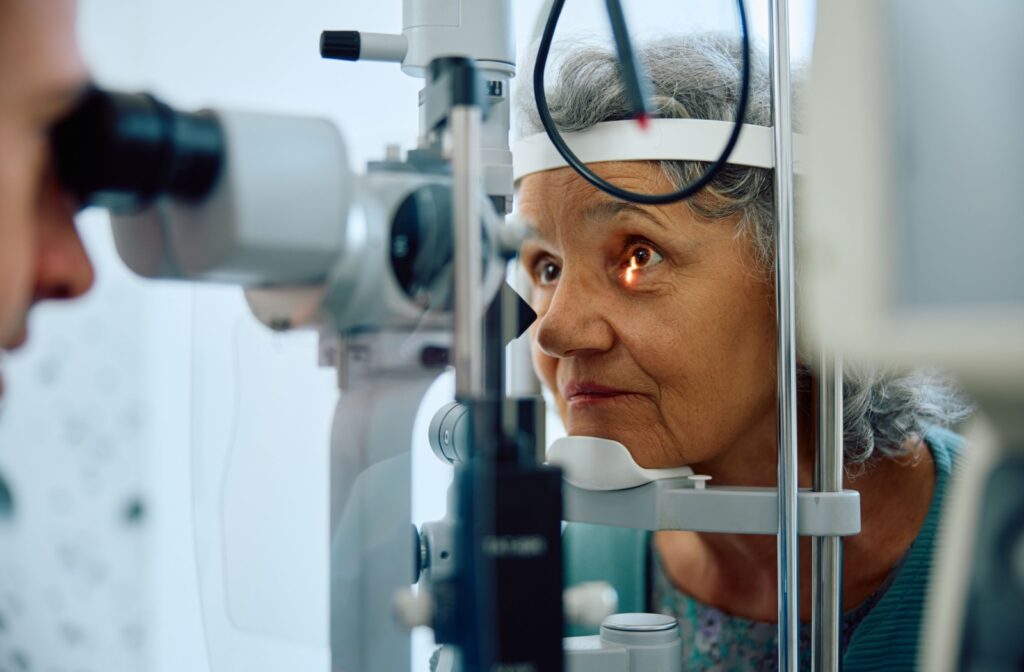Vision changes over time are completely normal, but not always predictable. Many adults notice that their eyesight shifts gradually as the years go by, particularly in their ability to read up close or see objects at a distance. In most cases, distance vision typically worsens, not improves, as you get older.
What Happens to Vision as You Age?
Just like the rest of your body, your eyes go through natural wear and tear over the years. Some of the most common age-related vision changes include:
- Presbyopia: Around the age of 40, the eye’s natural lens begins to lose flexibility, making it harder to focus on close objects. You may find yourself holding reading materials at arm’s length or needing reading glasses.
- Reduced tear production: Tear glands become less effective over time, which can lead to dryness and irritation.
- Lens stiffening and yellowing: This can cause blurry vision and make it harder to see contrasts, especially in low light.
While these changes mostly impact near vision, your distance vision isn’t immune. Age-related conditions like cataracts and macular degeneration can interfere with your ability to see objects far away.
Why Some People Think Their Vision Is Improving
Occasionally, people who have been nearsighted (myopic) for most of their lives report that they suddenly don’t need their glasses as much. It might seem like their distance vision is improving, but what’s really happening?
Often, this is linked to the early stages of cataract development. As cataracts begin to form, they can alter the way light passes through the lens, temporarily “offsetting” the effects of myopia. This shift can make distance vision seem clearer, but it’s not a true improvement. It’s a side effect of an underlying condition.
Another possibility is changes in blood sugar levels. In people with diabetes, fluctuating blood sugar can affect the shape of the lens and lead to temporary changes in vision. Again, this isn’t a positive or permanent shift, it’s a red flag that something more serious may be occurring.
Common Age-Related Eye Conditions That Affect Distance Vision
As we age, several eye diseases can develop that impact distance vision:
Cataracts
These cause clouding of the eye’s natural lens. In very early stages, cataracts may shift your prescription and make you feel like your vision is improving, but as the cataract progresses, your vision will become increasingly blurred and dull.
Age-Related Macular Degeneration (AMD)
This condition damages the macula, the part of the retina responsible for sharp central vision. AMD can distort both near and distance vision, making it difficult to drive or recognize faces.
Glaucoma
Often called the “silent thief of sight“, glaucoma damages the optic nerve and typically affects peripheral (side) vision first, but without treatment, it can impact all areas of your vision, including distance vision.
What About Sudden Changes in Vision?
Sudden changes in vision, whether it’s a sharp decline or unexpected improvement, should always be taken seriously. If your vision improves suddenly, especially after years of stable prescriptions, it may indicate:
- Cataract progression
- Retinal detachment or damage
- Glaucoma flare-up
- Diabetic retinopathy
- Stroke or neurological issues
In short, a sudden boost in visual clarity is more often a warning sign than a miracle. If it happens to you, don’t wait! Schedule a comprehensive eye exam as soon as possible.

How to Protect Your Distance Vision as You Age
While you can’t stop the clock, you can take steps to support your long-term eye health and preserve your distance vision:
Stay on top of regular eye exams
A comprehensive eye exam can detect early signs of age-related eye conditions, often before symptoms arise. Your optometrist can track subtle changes and update your prescription as needed.
Wear proper correction
Glasses or contact lenses can do more than help you see clearly—they also reduce eye strain and help your eyes function more comfortably.
Prioritize eye-friendly nutrition
A diet rich in leafy greens, colorful fruits, omega-3 fatty acids, and antioxidants supports eye health. Nutrients like lutein, zeaxanthin, and vitamins A, C, and E are particularly beneficial.
Manage chronic health conditions
Conditions like high blood pressure and diabetes can impact your eyes. Keeping these under control reduces your risk of complications.
Protect your eyes from UV damage
Long-term exposure to ultraviolet light can increase your risk of cataracts and macular degeneration. Wear sunglasses with 100% UVA and UVB protection.
So, Can Distance Vision Improve with Age?
In most cases, distance vision tends to decline with age due to natural changes in the eye’s structure and function. Any sudden or seemingly positive shift in your vision is worth investigating, as it may be a symptom of an underlying condition that needs prompt attention.
That said, healthy habits, consistent care, and early detection go a long way in maintaining clear, comfortable vision well into your later years.
At Pacific Eyecare Optometry in Los Angeles, CA, our team is here to help you stay ahead of age-related vision changes, whether you’re noticing blurry distance vision or unexpected clarity. Book a comprehensive eye exam with us today and get the personalized care your eyes deserve.



